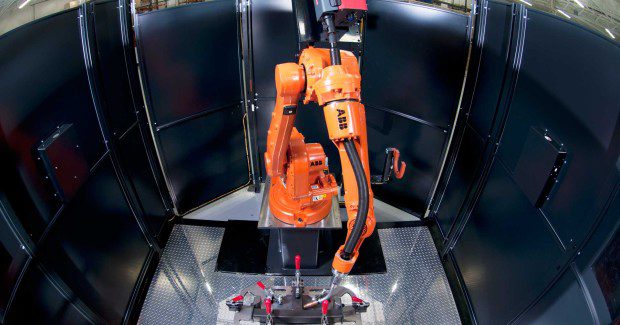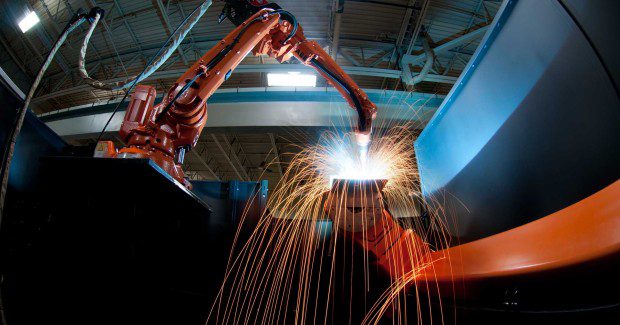Automation for the Small Job Shop: Why and What to Do with It
In part one of this three-part series, we examine how the simplicity, easy training and quick startup of new plug-and-play robotic cells – some for as little as $35,000 – can help even the smallest shops overcome labor shortages and become more competitive.
Posted: September 20, 2013
As the economy continues to stabilize, small- to mid-market job shops are increasingly looking to robotic welding automation to improve their productivity and gain a competitive advantage. In addition to the well-publicized challenges shops have in finding, hiring and retaining qualified welders, there are several other key factors that have recently converged to foster this trend.
PROGRAMMING SIMPLICITY AND ACCESSIBLE COMPETITIVE ADVANTAGES
One of the most prominent factors is that the evolution of more intuitive simulation and programming software for industrial robots is now at the point where the programming of robots is user friendly, even for complex applications. The point-and-click interface of the new software advancements makes it far easier to accurately and quickly weld small volumes of highly diverse parts.
Also contributing is the nature of the competitive marketplace, which is truly global for companies of all sizes, intensifying the challenge to deliver the quality and service that customers demand at a price that’s in line with both domestic and offshore competition. A significant step in the equation is to offset the disparity in offshore labor costs with capital investment in automation.
Every year the International Federation of Robotics (IFR) issues statistics on the top applications for industrial robots. Here are examples from the top 10 appliations, including Arc Welding, Spot Welding, Materials Handling, Machine Tending, Picking Packing Palletizing, Painting & Assembly.
Job shops have also been learning that integrating industrial robots into their operations provides numerous benefits, including increased productivity, improved quality, more efficient use of materials, less scrap and greater production flexibility. The recent introduction of economically attractive robotic systems that can be up and running in a matter of hours, rather than days, has greatly reduced the barriers, both real and perceived, for job shops to fully realize the great potential of robotic automation.
THE TRANSFORMATION OF THE INDUSTRIAL ROBOT
Over the last few years the industrial robot and the peripheral equipment and systems required to operate it have gone through a prominent transformation. The robotic arm itself has become lighter, stronger and faster. With less weight the robot requires a smaller base, takes up less space, requires a smaller work cell and can often be mounted to a wall or an overhead frame. This makes a robot far easier to integrate into an existing operation or install in a shop with limited space.
The technology employed in the controller has become smaller, faster, cheaper and more reliable than ever. The architecture is more accessible and open to talk to a greater variety of external devices. The welding power sources have advanced at a significant pace too, enabling them to produce an arc which is more accommodating to wider component tolerances and providing reduced heat input per unit length of material.
The intelligence level of the various components of a robotic cell has also evolved. The standardization of bus communication now provides end users with the ability to literally plug-in and begin producing. Historically the interface between a robot and power source was something that took time and skill to integrate. Today the units are intelligent enough to recognize each other and start communicating automatically, drastically reducing the time and acclimation period needed to set up a robotic welding operation.
This transformation has begun to change the perception that robotic welding is only viable for large companies that meet the necessary volume threshold by welding huge batches of the same part with stringent repeatability.
BEGINNING TO PLAN FOR ROBOTIC AUTOMATION
Despite these advancements, the successful integration of a robotic welding operation requires a thorough planning phase prior to cell design and purchase consideration.
A thorough helicopter review of the manufacturing processes in the work theater is a critical initial step. Understand the work flow, the bottlenecks and where potentially excessive levels of manpower exist. Evaluate parallel processes that could be combined or made more efficient, and envision the most efficient layout of the complete production process on the shop floor.
It is also important to keep an open mind. It may be that automating the current manual welding process is not the best solution. There may be other, more capable processes that optimize the speed and quality of welds across the family of processed parts. As the components that are desired and needed for the robotic system begin to be identified, it is advisable to initiate a relationship with a robotic integrator that specializes in welding applications to assess and design the most appropriate system.
It may be that a preconfigured robotic welding cell makes the most sense. Several leading robotic manufacturers have developed pre-engineered, standard solutions that can be up and running in a day or less. One example is our IRB 1520ID two-station ArcPack welding system, a modular, cost-effective and compact means to initiate or upgrade an automated welding operation. With only a 9 ft x 9 ft footprint and an economical price point, this new system makes it feasible for even the smallest welding shops to get into robotic welding.
If a more custom system is needed, a qualified integrator will often start the design process by using a 3D simulation software product. A software like our RobotStudio technology has become the cornerstone of the design process, allowing virtual robotic systems to be completely configured on a PC with all the necessary components, in the optimum layout and flow, complete with the resulting performance metrics.
This allows a system to be fully assessed before a commitment is made, significantly limiting the risk of the investment. Reach studies establish the best way to process the parts, and the resulting cycle times are accurately identified to assure the correct use of the most appropriate technologies available.
Another advantage of the PC-based simulation in RobotStudio, along with an application specific add-on like the Arc Welding PowerPac, is that it allows the same simplicity and accuracy in programming the robotic system for welding the full array of parts once the system has been designed and installed. The virtual program defines weld locations on the CAD geometries and the system automatically creates robot positions in relation to that geometry, including approach and departure positions. Once the simulation is complete, the RobotStudio model is ready to be transferred directly into the robot controller for cell operation.
The following steps may also be helpful in determining if robotic automation is viable for specific applications and, if so, what form the system will take:
• Establish a relationship with a qualified system integrator. Even if a preconfigured cell is the most appropriate route, an integrator will be an invaluable resource throughout the entire process and beyond.
• Try to connect and learn from a recent adopter of robotic automation in an allied industry; someone who has gone through the similar learning curve process can provide valuable impartial information regarding a successful startup.
• Participate in the formal training classes and the online forums for knowledge.
• Establish an internal project team early in the process and make sure they fully participate in all educational and planning activities. Spreading the ownership of the system will help ensure a smooth start-up.
• Concept a cell with a feasible level of flexibility relative to the industry and customer base, and consider the nature of new parts the system may need to handle in the future.
• Consider cell logistics regarding material flow to and from the cell.
• Utilize common base cell technology for rapid deployment and compressed start-up time
• Introduce the more basic components as the first job. Allow the knowledge curve to be readily attainable.
Robotic automation is geared to high flexibility, empathetic to low volume processing with high mix of disparate components. Following some of these guidelines early in the process will provide you with a standard of high quality day in day out.
In part two of our series next month, we will cover the mechanics of process control on the floor, flexibility, and the specific capabilities of welding in the lean manufacturing environment, with an emphasis on how robots handle such a variety of part sizes and shapes.













